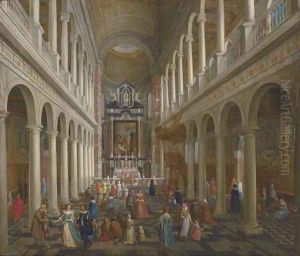Wilhelm Schubert Van Ehrenber Paintings
Wilhelm Schubert van Ehrenberg was a Flemish painter known primarily for his baroque architectural and interior paintings. Born in 1637 in Antwerp, he was a part of the prolific artistic environment in the Southern Netherlands during the mid-17th century. Although not as widely recognized as some of his contemporaries, van Ehrenberg's work provides a fascinating insight into the artistic trends and influences of his time.
Van Ehrenberg received his artistic training in the studio of the painter Pieter Neefs the Elder, who was also renowned for his architectural interiors. This apprenticeship significantly influenced van Ehrenberg’s style and choice of subject matter. His works are characterized by intricate depictions of lavish church and palace interiors, often embellished with gothic and baroque elements that were popular during the period.
Despite the relatively small oeuvre that he left behind, van Ehrenberg’s paintings stand out for their attention to detail and the use of light and shadow to create depth and perspective. He was adept at painting the effects of both natural and artificial lighting on interior spaces, which added a dramatic and realistic element to his compositions. His artworks typically included figures, but these were often secondary to the grandeur of the architectural setting.
Van Ehrenberg's career also included collaboration with other artists, which was a common practice at the time. He would often paint the architectural elements of a composition while other artists, such as David Teniers the Younger, would paint the figures. This collaborative approach to art-making allowed van Ehrenberg to focus on his strengths and contributed to the creation of multi-dimensional works that combined the best of both artists’ talents.
Wilhelm Schubert van Ehrenberg passed away in 1676. His legacy may not be as extensive as some of his contemporaries, but his work remains an important representation of Flemish baroque interior painting. Today, his paintings can be found in various art collections across Europe, providing a window into the opulent interiors of the 17th century.
